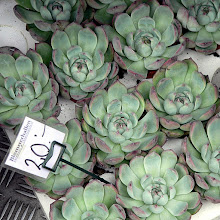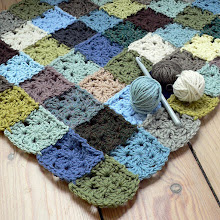 This morning I did a little experiment with my acrylic paints. I wanted to see what differences the addition of white and black made to the pigments.
This morning I did a little experiment with my acrylic paints. I wanted to see what differences the addition of white and black made to the pigments.I've read a lot about whether to use black in painting or not, and I must confess to a degree of confusion over this. Black muddies the colours, right? And muddying is not good, is it? It's better to tone down your colour with its complementary, isn't it? Or is it? Because I really like muddy colours...
I thought the best way to explore this properly was to see what really happened to my colours when black (and white, to create tints) was added. And so I did an experiment. I painted little squares of all my paints straight out of the tube (bottom left). Then I added white to each one to make a tint (top left). Next, I started with tube colours again and added a very little black to each one (bottom right). Finally, I tinted these muted colours (top right). And this was the result:
 Looking at these, I experienced a strong attraction to many of the colours, as well as quite a dislike of others. I thought it would be interesting to see which 'palette' held the colours I liked the best, if any.
Looking at these, I experienced a strong attraction to many of the colours, as well as quite a dislike of others. I thought it would be interesting to see which 'palette' held the colours I liked the best, if any.So, I tore up lots of little bits of white paper, and I covered over all the colours I didn't much like. This was the result:
 Several of the pure tints went straight away, as did many of the original pigments. Then I decided to get more ruthless and leave only colours I actively liked:
Several of the pure tints went straight away, as did many of the original pigments. Then I decided to get more ruthless and leave only colours I actively liked: Not many left! And most of the brights gone. All the pure tints obscured except the muddy earth colours. But I still felt I hadn't been quite honest. Did I really like that bright red, and that ultramarine tint? No. So I did a final cull, leaving only colours I liked a lot and felt I might want to use:
Not many left! And most of the brights gone. All the pure tints obscured except the muddy earth colours. But I still felt I hadn't been quite honest. Did I really like that bright red, and that ultramarine tint? No. So I did a final cull, leaving only colours I liked a lot and felt I might want to use: Half the colours gone now. But what did remain was of interest: eleven 'pure' colours to seventeen 'blackened'... nine tinted colours to eighteen untinted. An extraordinarily clear preference for the blackened but untinted palette.
Half the colours gone now. But what did remain was of interest: eleven 'pure' colours to seventeen 'blackened'... nine tinted colours to eighteen untinted. An extraordinarily clear preference for the blackened but untinted palette.So, what to make of this information? The blackened, muddied colours that I feel like I 'shouldn't' be using turn out to be my favourites... Now, because I am someone who likes playing by the rules, this worries me. I'm also wondering how to use this information... should I stick to this palette to achieve work I like, or should I see it as a challenge to introduce colours I don't initally warm to, in order to broaden and open out my palette?
I would really welcome comments from anybody with experience of these questions and of painting. What are your feelings about using black as a mixing colour?
Out of interest, the colours, in a clockwise circle from bottom left to bottom right were:
Titanium White
Lemon Yellow
Azo Yellow Medium
Yellow Ochre
Burnt Sienna
Napthol Red Light (Cadmium Red would be better)
Alizarin Crimson
Ultramarine
Phthalo Blue (red shade)
Phthalo Blue (green shade)
Phthalo Green
Olive Green
Raw Umber
Burnt Umber
Mars Black














